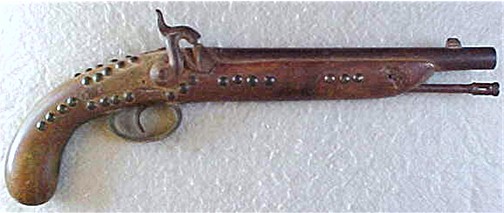|
19TH CENTURY ENGLISH PISTOL WITH BRASS
TACKS - SHOWING SOLID EVIDENCE OF USE BY INDIANS – GREAT
WESTERN FRONTIER PISTOL: This early to mid 19th
Century pistol shows all indication of having been
supplied through the British Government to the North
American Fur Trade, and its subsequent use by a Native
American. The brass tack decoration appears to have
been applied during the period of use, and is not some
later added 20th Century affectation. Much
scarcer than the Northwest Trade Muskets and other
Indian used long guns, a righteous Indian used pistol is
a special addition to any frontier collection and one
that appears very seldom on the market.

The stock is decorated with tacks distributed. along
both sides of the forestock, both sides of the grip, and
lines paralleling the lock plate and trigger guard. The
tack heads show appropriate wear, and have the
appearance of having shrunk into the wood, something
that only happens with age and use. There are two tack
heads which have broken away – one on the right side
immediately above the trigger, and one on the left side
just forward of the breech. The remaining shank from
that second missing tack head confirms these tacks are
solid brass with square shanks – the type known to have
been available well back into early Fur Trade era.
Again, the tacking present on this pistol not only
appears genuine in the style of the tacks, the
appearance of the tack heads, and they way they have
pulled down into the wood grain, but they are also
applied in a pattern which is typical of other known
genuine Indian tacked guns, not one of the goofy, humped
up designs applied by modern collectors attempting to
sweeten up an old worn out gun.
Measuring 16 ˝” long, this pistol presents as one of a
size and style that would have been present on the early
frontier – one that was large enough, and heavy enough
to have been useful in self defense, and sufficiently
robust to withstand the rigors of hard daily use.
The 10 ˝” long barrel has a
rifled bore, approximately .62 caliber, which is the
characteristic caliber of the Northwest Trade Muskets
supplied to the Indians at the frontier trading posts.
The rifling, strong and quite prominent for its length,
stops within about 1” of the muzzle – a common feature
which left a smooth surface at the mouth of the muzzle
to make it easier to start a ball down the bore during
the loading process. The breech has flats which then
transition into a round profile for the balance of the
length. There is a front sight, but no provision for a
rear sight. Evidence that this pistol served a long and
active life on the frontier, it is fitted with the front
section of a ram rod from an Enfield Rifle. Cut down
to fit the length of the pistol’s barrel, the rod
retains the full profile of the rod tip, the rod fits
snugly in the ramrod hole - testament that it has been
with the pistol for a long time, and the finish of the
rod matches the rest of the pistol’s iron surfaces.
The left side of the barrel is stamped with a series of
British proof marks, the most significant of which is
the British government “Broad Arrow” stamp which
indicates government ownership. The British government
was heavily involved in maintaining control over the
Indian trade in North America as they had from the
earliest days of colonization. After the American
Revolution, the British influenced Indian Trade
continued as an active business venture across Canada,
and south of the “49TH Parallel” into the
disputed Northwest frontier until the mid-19th
Century when the Oregon Territory was secured by the
United States. That this government stamp is applied to
a pistol which is not of one of the known British
military pistols strongly argues that this pistol was
definitely intended for the Indian trade. The barrel
has an overall aged brown finish which is generally
smooth with no heavy pitting.
The stock has a nice profile including a well shaped
round butt grip and a fore stock that extends almost the
full length of the barrel. The wood has an even patina,
and while showing signs of actual use, there is no
significant damage which affects the structural
integrity of the stock. There is an area dug out around
the iron pin which secures the barrel in the stock,
probably from where a previous owner or early gunsmith –
likely of the period of use – needed to remove the
barrel for some repair function.
The back action lock functions properly, holding
properly at half and full cock. The trigger releases
the hammer for a solid, crisp fall, but there is a
little sluggishness in the movement of the hammer,
probably due to a build up of old debris on the internal
components of the lock. The finish of the lock plate,
trigger and screw heads have the same naturally aged
finish, turning to smooth brown where the surfaces have
been handled. The brass trigger guard has a naturally
aged patina.
This early pistol is an evocative survivor of the
western Indian Wars which occurred before and after the
Civil War, with all of the features present one looks
for in a genuine Indian used firearm. This is one that
will be almost impossible to better without dipping into
one of the very few well established collections of
these special guns that are quietly held around the
country. Very rarely does a pistol such as this one
come to the surface to be offered on the open market,
and this is a prime opportunity to acquire a very
attractive specimen.
SOLD
|

